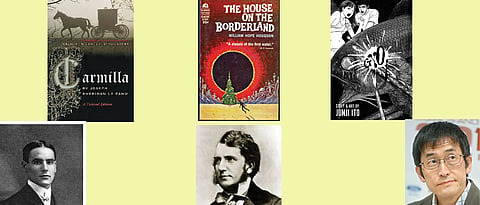

The horror genre has been shaped by master writers, from H G Wells to Edgar Allan Poe, Alfred Hitchcock and Stephen King. H P Lovecraft was another important name. The elements these writers crafted to spook up their tales have defined the genre. However, down the ages, some horror meisters have faded into oblivion, their contribution to the genre notwithstanding. We write about a few such authors whose works have spawned popular subgenres – vampire novels for instance.
Kept it ambiguous
Joseph Sheridan Le Fanu was an Irish author whose repertoire spanned both horror and the historical. But his work in the horror genre is considered more influential. His writings are a cornerstone in the development of the genre during the Victorian era.
Le Fanu’s stories are some of the first ones to rely on suggestion, instead of outright imagery, to express shock and horror, keeping key mysteries ambiguous.
Most of us believe Dracula to be the first modern vampire novels, but it is very closely influenced by Le Fanu’s much shorter novella Carmilla. His The House by the Churchyard was a key source for one of James Joyce's earlier works, Finnegans Wake. Also, Carmilla is one of the few works where the character’s sexuality may veer towards the queer end. The novel can be rightly said as a precursor of the lesbian vampire trope.
Time connect with sea
British writer Alan Moore, who has penned V for Vendetta and Watchmen (the only graphic novel to make it to Time’s 100 books list) has a penchant for using old masters creations in his work. Thus, we see William Hope Hodgson’s occult detective Thomas Carnacki turn up in Moore’s The League of Extraordinary Gentlemen.
Hodgson’s work comprises not only Gothic horror, but also science fiction. One of the curious aspects of his horror tales is that they are almost all time connected to the sea. Those influenced by his work include Olaf Stapledon, Iain Sinclair and Gene Wolfe.
Two of Hodgson’s works stand out. First is The House on the Borderland. It takes the usual setting of a haunted house occupied by a recluse, who is your classical unreliable narrator. What starts out as a ghost story turns into a H P Lovecraftian cross-dimensional tale. Towards the end, you wonder what really did happen. His second work is The Night Land, a sombre story set in a future where the sun has extinguished.
Set in cruel world
We have all heard of J-horror (Japanese horror), with films like The Curse and Rings routinely making top 10 best lists. Yes, Japanese anime has a subgenre for horror. And, one of its most influential writers is Junji Ito. While most of Ito’s works are hugely influenced by HP Lovecraft, his works also include aspects of body horror. Most of Ito’s tales are set in a cruel world, where good people find themselves in bad situations. His Tomie revolves around a demon while his Gyo features a couple fighting a mysterious horde of undead fish with metal legs powered by an odour known as the “death stench”.
